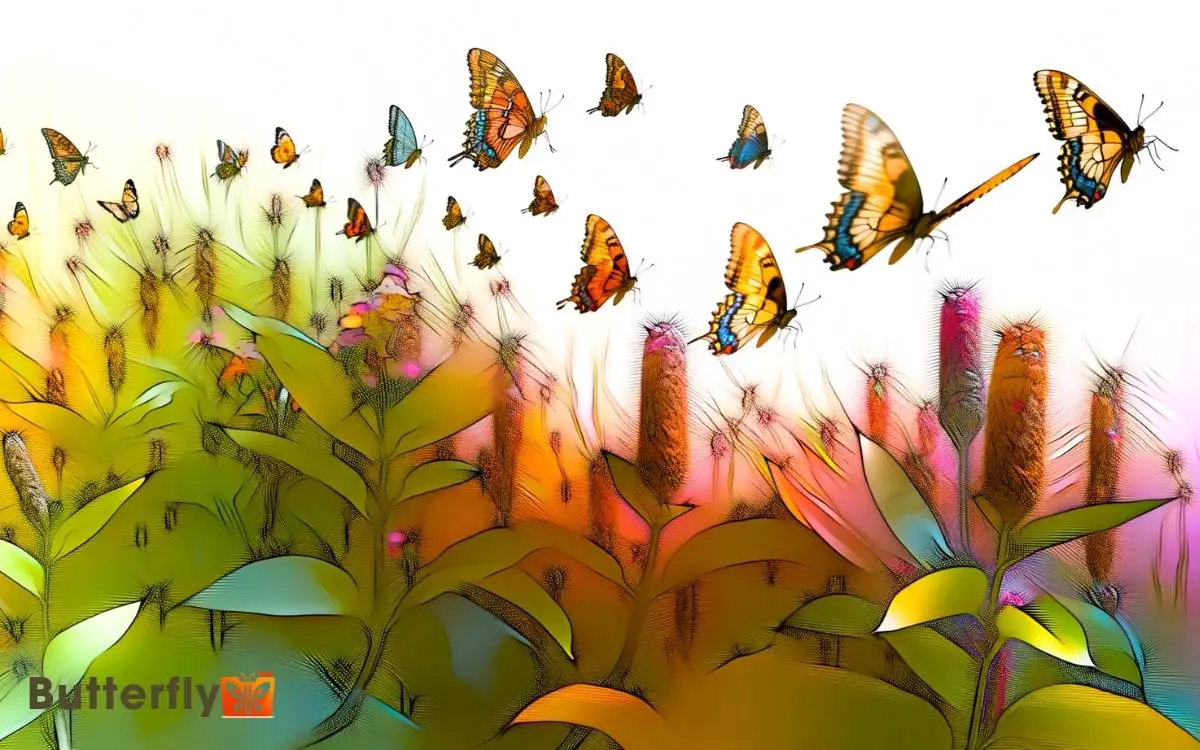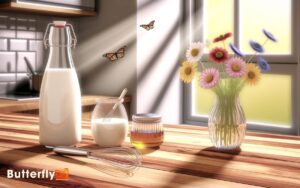How To Draw Butterflies And Flowers? Quick Steps!
Start by gathering your sketchpad, pencils, erasers, and colored pencils or paints. To draw a butterfly, sketch the thorax, head, and wing outlines, making sure to keep them symmetrical.
Add details like veins and shading. For flowers, begin with simple shapes; then, sketch petals and stems. Bring your butterfly and flower together by placing the butterfly on a petal, adding interaction and guiding the eye through the drawing.
Enhance your art with background elements like clouds and grass. Don’t forget to refine your outlines with a black ink pen. Keep adding details and you’ll soon create beautiful, immersive scenes.

Key Takeaways
Gather Your Materials
To begin your artistic adventure, gather essential materials like sketchpads, pencils, erasers, and colored pencils or paints.
Start by choosing a high-quality sketchpad; it’ll give your creations a solid foundation. Select a range of pencils, from soft to hard, to produce diverse lines and shading.
Keep a reliable eraser handy for refining details and correcting mistakes. Colored pencils or watercolors will help you bring your butterflies and flowers to life with vibrant hues.
Innovation thrives on experimentation, so don’t hesitate to explore different mediums. Maybe try pastels or ink for unique effects. Organize your materials within easy reach to maintain a smooth workflow.
With everything ready, you’re all set to commence on your creative journey, transforming imagination into beautiful art.
Basic Drawing Techniques
Mastering basic drawing techniques sets the stage for creating stunning butterflies and flowers, so let’s immerse ourselves in the essentials.
Start with simple shapes circles, ovals, and lines. Use light pencil strokes to sketch these forms. This helps you build a foundation without committing to heavy lines.
Next, practice shading. Hold your pencil at a slight angle and apply varying pressure to create light and dark areas. This adds depth and dimension. Experiment with hatching and cross-hatching for texture.
Drawing Butterfly Outlines
With your basic drawing techniques in place, start by sketching the butterfly’s body using an elongated oval for the thorax and a smaller circle for the head. Next, draw two intersecting lines to form a cross through the thorax.
This will help position the wings accurately. Follow these steps:
| Step | Action | Result |
|---|---|---|
| 1 | Sketch thorax & head | Basic body shape |
| 2 | Draw intersecting lines | Wing placement guide |
| 3 | Add wing outlines | Butterfly structure |
Now, draw the upper wings by extending curved lines from the top of the thorax, then sketch the lower wings from the bottom. Keep the shapes symmetrical and fluid.
This foundation sets you up for adding intricate details later. Keep practicing, and you’ll innovate beautiful butterfly designs!
Adding Butterfly Details
Now that you’ve explored the basic structure, let’s dive into adding intricate patterns and textures to bring your butterfly to life. You can experiment with different line weights and shading techniques to create a sense of depth and realism in the wings. Observing real butterflies or even finding butterflies in your backyard can provide inspiration for unique patterns and natural color combinations. Don’t be afraid to mix bold shapes with delicate details to make your butterfly truly stand out.
- Start by sketching the veins on the wings, which mimic the delicate network seen in real butterflies.
- Use light, sweeping strokes to create a natural flow.
- Next, add small circles and teardrop shapes along the edges of the wings for a whimsical touch.
- Don’t forget to draw tiny antennae with a slight curve for a realistic look.
- Enhance the body by etching fine lines to indicate segments.
- Finally, introduce subtle shading to give depth and dimension.
Coloring Butterflies
Now that you’ve added all the details, it’s time to bring your butterfly to life with color.
- Start by choosing a vibrant color palette that captures the beauty of real butterflies.
- Next, use blending techniques to create smooth shifts and gradients, making your butterfly look as natural and stunning as possible.
Choosing Color Palettes
As you begin to color your butterflies, start by selecting a color palette that captures the vibrant essence of these delicate creatures.
Think about the natural hues found in butterfly wings and how they can inspire your choices. Don’t hesitate to mix bold and subtle shades to bring your artwork to life.
| Palette Option | Suggested Colors |
|---|---|
| Tropical | Bright oranges, vivid blues, yellows |
| Woodland | Earthy browns, deep greens, creams |
| Fantasy | Purples, pinks, metallic silvers |
By thoughtfully selecting colors, you’ll create a stunning, lifelike butterfly that truly stands out.
Blending Techniques
Mastering blending techniques allows you to create smooth changes and realistic gradients on your butterfly wings, adding depth and dimension to your artwork.
Begin by selecting two or three complementary colors. Lightly shade the connection areas with the lightest color first.
Gradually layer the medium and dark colors, overlapping slightly to guarantee a seamless blend. Use circular motions for even application. Don’t rush; patience is key.
To enhance smoothness, use a blending stump or a soft brush to soften lines and merge colors. You can also utilize a colorless blender pencil for an extra polished effect. Experiment with pressure variation to achieve dynamic transitions.
Practice these steps, and you’ll see your butterflies come to life with vibrant, realistic hues.
Sketching Flower Shapes
Start by drawing basic flower outlines, focusing on the overall shape and structure. Once you’ve got the outline, add details to each petal, making them appear more natural and unique.
Basic Flower Outlines
To begin sketching flower shapes, focus on drawing simple geometric forms like circles and ovals that will establish the foundation of your flower outlines.
Start by drawing a small circle for the flower’s center. Next, sketch larger circles or ovals around this center to represent the overall shape and size of the flower.
Experiment with different sizes and placements to create unique and innovative flower designs. Make sure to lightly sketch these shapes so they can be easily adjusted.
Adding Petal Details
With the basic outlines in place, you can now focus on adding petal details to bring your flower sketches to life. Start by lightly sketching the veins of each petal. These lines should curve naturally, emanating from the base of the petal to its tip.
Pay attention to the unique characteristics of each flower type; for instance, rose petals have softer, more rounded veins, while daisies showcase straight, elongated lines. Add subtle texture by drawing tiny lines or dots near the edges for a realistic touch.
Experiment with varying pressure on your pencil to create depth and dimension. Remember, each petal is unique, so embrace the slight imperfections they add character and authenticity to your artwork. Innovate and explore!
Shaping Flower Centers
Focusing on the center of the flower, begin by sketching a small circle or oval where all the petals converge. This central shape sets the foundation for your flower’s symmetry and balance.
Next, add texture by lightly shading or adding tiny dots within the circle to mimic pollen. Don’t be afraid to experiment with different shapes; some flowers have star-like centers or layered circles.
Once you’ve nailed the center, draw the surrounding petals, ensuring they overlap naturally. Keep their size proportionate to the center. For a more dynamic look, vary the petal shapes slightly.
Practice makes perfect, so try sketching several flower centers to see which styles you find most engaging and inventive.
Detailing Petals and Leaves
Start by observing the intricate patterns on each petal and leaf, noting the subtle curves and textures that make them unique. Pay close attention to the natural lines and veins running through them.
To detail your petals and leaves effectively, follow these steps:
- Outline the Shape: Lightly sketch the outer edges of the petals and leaves, ensuring you capture their unique contours.
- Add Veins and Folds: Draw the central vein first, then add smaller veins branching out. For petals, add gentle folds to show their delicate nature.
- Enhance with Line Variation: Use different pressures on your pencil to create thin and thick lines, adding depth and realism.
Shading and Texture
To create lifelike butterflies and flowers, start by highlighting depth effectively with varied shading techniques.
Next, add realistic textures by using different strokes and pressure with your pencil.
Highlighting Depth Effectively
Mastering shading and texture in your butterfly and flower drawings will bring your artwork to life, adding depth and realism with each carefully placed stroke.
To highlight depth effectively, follow these steps:
- Use Gradient Shading: Gradually shift from dark to light to create a sense of volume. Apply more pressure for darker areas and lighten your touch for softer shadows.
- Layer Your Strokes: Build up texture by layering strokes. For butterfly wings, use short, overlapping lines; for petals, employ longer, sweeping strokes.
- Highlight with Contrast: Focus on contrasting light and dark areas. Highlight the edges where light hits directly, and deepen shadows in recessed areas to enhance the three-dimensional effect.
With these techniques, you’ll innovate your drawings with dynamic depth and texture.
Adding Realistic Textures
When adding realistic textures to your butterfly and flower drawings, focus on varying your pencil pressure and stroke direction to mimic the natural intricacies of their surfaces.
Start by lightly sketching the main areas where texture is most prominent. For butterfly wings, use short, delicate strokes to emulate the fine scales. Adjust your pressure to create darker and lighter areas, enhancing depth.
On flower petals, employ gentle, curved lines to capture their subtle, velvety texture. Don’t hesitate to experiment with crosshatching for denser areas like the center of the flower.
Blending for Smoothness
After detailing textures on your butterflies and flowers, you can enhance their realism by smoothly blending your shading to create a seamless, lifelike look.
Here’s how to achieve that innovative touch:
- Use a blending tool: Choose a blending stump or soft brush to gently smooth out the pencil lines. This helps create gradients that mimic natural light and shadow.
- Layer gradually: Apply multiple layers of light shading rather than one heavy layer. It allows you to build depth and maintain the smoothness.
- Blend with a circular motion: Using small, circular strokes while blending ensures an even distribution of graphite or color, giving a more natural appearance.
Combining Butterflies and Flowers
To seamlessly combine butterflies and flowers in your drawings, start by sketching the basic shapes of the flowers, ensuring there’s ample space for the butterflies to be added later.
Focus on positioning the flowers in a way that guides the eye naturally.
Next, decide where the butterflies will land or hover. Draw light, fluid lines for the butterflies’ flight paths, creating a sense of movement.
Add details to the butterflies, ensuring their wings interact organically with the petals. Think about scale and balance; a tiny butterfly on a large bloom can create an exciting contrast.
Adding Background Elements
Adding background elements can transform your butterfly and flower drawings from simple sketches into vibrant, lifelike scenes. Start by envisioning the environment where your subjects thrive.
Here’s how:
- Draw Soft Clouds: Lightly sketch fluffy clouds using gentle, curved lines. Blend with a tissue for a soft appearance.
- Add Gentle Grass: Create a sense of depth by drawing tall and short grass blades. Use varied strokes for a natural look.
- Incorporate Distant Trees: Outline tree shapes in the background with lighter shades to add depth. Mix different tree types for diversity.
These steps will elevate your artwork, making it more immersive and dynamic. Experiment with these elements to innovate and bring your scenes to life.
Final Touches and Tips
With your background elements in place, let’s focus on the final touches that will give your butterfly and flower drawings that polished, professional look.
Start by enhancing details with fine lines and bold outlines. Add shading to create depth and dimension, using light strokes for subtle shadows. Highlight key areas with a white gel pen for contrast and realism.
Here’s a quick reference to help you:
| Step | Action | Tools Needed |
|---|---|---|
| 1 | Enhance details | Fine-line pens |
| 2 | Add shading | Pencils or markers |
| 3 | Highlight key areas | White gel pen |
| 4 | Refine outlines | Black ink pen |
| 5 | Check proportions | Ruler or grid paper |
Conclusion
You’ve gathered your materials, mastered the basics, and brought butterflies and flowers to life on your canvas.
Now, pause and look closely do you see where a touch more shading might bring depth? Maybe a hint of color will make your butterfly wings flutter? Trust your instincts.
With each stroke, you’re not just drawing; you’re creating a world. Your masterpiece awaits its final flourish.
Are you ready to make it truly unforgettable? Go ahead, take that last step.






